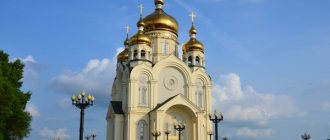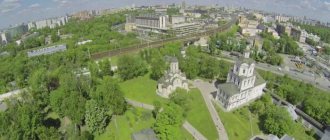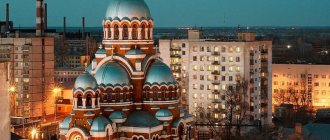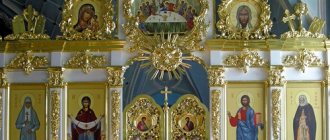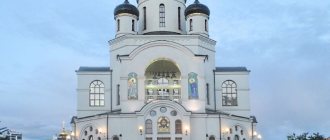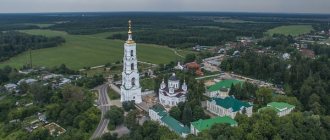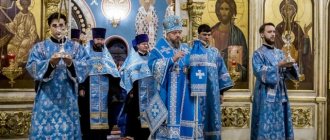Mir
Russia Yaroslavl region Rybinsk Spaso-Preobrazhensky Cathedral (Rybinsk) Map is loading…
{"format":"leaflet","minzoom":false,"maxzoom":false,"limit":50,"offset":0,"link":"all","sort":[""], "order":[],"headers":"show","mainlabel":"","intro":"","outro":"","searchlabel":"\u2026 \u0441\u043b\u0435\ u0434\u0443\u044e\u0449\u0438\u0435 \u0440\u0435\u0437\u0443\u043b\u044c\u0442\u0430\u0442\u044b","default":"","import-annotation":false,"width ":"auto","height":"350px","centre":{"text":"","title":"""link":"","lat":58.04832999999999998408384271897375583648681640625,"lon": 38.85833000000000225782059715129435062408447265625,"icon":""},"title":"","label":"","icon":"","lines":[],"polygons":[],"circles":[ ],"rectangles":[],"copycoords":false,"static":false,"zoom":8,"defzoom":14,"layers":["OpenStreetMap"],"image layers":[] ,"overlays":[],"resizable":false,"fullscreen":true,"scrollwheelzoom":true,"cluster":false,"clustermaxzoom":9,"clusterzoomonclick":true,"clustermaxradius":80, "clusterspiderfy":true,"geojson":"","clicktarget":"","showtitle":true,"hidenamespace":false,"template":"","userparam":"","activeicon": "","pagelabel":false,"ajaxcoordproperty":"","ajaxquery":"","locations":[{"text":"\u003Cb\u003E\u003Ca href=\"/palomnik/%D0% A1%D0%BF%D0%B0%D1%81%D0%BE-%D0%9F%D1%80%D0%B5%D0%BE%D0%B1%D1%80%D0%B0%D0%B6 %D0%B5%D0%BD%D1%81%D0%BA%D0%B8%D0%B9_%D1%81%D0%BE%D0%B1%D0%BE%D1%80_(%D0%A0% D1%8B%D0%B1%D0%B8%D0%BD%D1%81%D0%BA)\» title=\»\u0421\u043f\u0430\u0441\u043e-\u041f\u0440\u0435\u043e\ u0431\u0440\u0430\u0436\u0435\u043d\u0441\u043a\u0438\u0439 \u0441\u043e\u0431\u043e\u0440 (\u0420\u044b\u0431\u0438\u043d\u0 441\u043a)\»\u003E\ u0421\u043f\u0430\u0441\u043e-\u041f\u0440\u0435\u043e\u0431\u0440\u0430\u0436\u0435\u043d\u0441\u043a\u0438\u0439\u0441\u0 43e\u0431\u043e\u0440 (\ u0420\u044b\u0431\u0438\u043d\u0441\u043a)\u003C/a\u003E\u003C/b\u003E\u003Chr /\u003E\u003Ca href=\"/palomnik/%D0%A1%D0%B2%D0 %BE%D0%B9%D1%81%D1%82%D0%B2%D0%BE:%D0%90%D0%BD%D0%BD%D0%BE%D1%82%D0%B0%D1% 86%d0%b8%d1%8f \ "title = \" \ u0421 \ u0432 \ u043e \ u0439 \ u0441 \ u04442 \ u0432 \ u043e: \ u0410 \ u043d \ u043d \ u0432 \ u0430 \ u0430 \ u0430 \ u0430 \ u0430 \ u0430 \ u0430 \ u0430 \ u0430 \ u0430 \ u0430 \ u. 0446 \ U0438 \ U044F \u003E\u0410\u043d\u043d\u043e\u0442\u0430\u0446\u0438\u044f\u003C/a\u003E: »'\u0421\u043f\u0430\u0301\u0441\u043e-\u041f \u0440\u0435 \u043e\u0431\u0440\u0430\u0436\u0435\u0301\u043d\u0441\u043a\u0438\u0439 \u043a\u0430\u0444\u0435\u0434\u0440\u0430\u0301\u 043b\u044c\u043d\u044b\u0439 \u0441\u043e\u0431\u043e\u0301\u0440"' (\u0421\u043e\u0431\u043e\u0440 \u0432\u043e \u0438\u043c\u044f \u041f\u0440\u0435\u0 43e\u0431\u0440\u0430\ u0436\u0435\u043d\u0438\u044f \u0413\u043e\u0441\u043f\u043e\u0434\u043d\u044f) \u0432 \u0420\u044b\u0431\u0438\u043d\u0441\ u043a\u0435 \u2014 \u043a\u0430 \u0444\u0435\u0434\u0440\u0430\u043b\u044c\u043d\u044b\u0439 \u0441\u043e\u0431\u043e\u0440\u043d\u044b\u0439 \u0445\u0440\ u0430\u043c\u0420\u044b\u0431 \u0438\u043d\u0441\u043a\u043e\u0439 \u0435\u043f\u0430\u0440\u0445\u0438\u0438 \u042f\u0440\u043e\u0441\u043b\u0430\u0432\ u0441\u043a\u043e\u0439\u043c \u0438\u0442\u0440\u043e\u043f\u043e\u043b\u0438\u0438 \u0420\u0443\u0441\u0441\u043a\u043e\u0439 \u043f\u0440\u0430\u0432\ u043e\u0441\u043b\u0430\u0432 \u043d\u043e\u0439 \u0446\u0435\u0440\u043a\u0432\u0438.","title":"\u0421\u043f\u0430\u0441\u043e-\u041f\u0440\u0435\u043e\u0431 \u0440\ u0430\u0436\u0435\u043d\u0441\u043a\u0438\u0439 \u0441\u043e\u0431\u043e\u0440 (\u0420\u044b\u0431\u0438\u043d\u0441\u043a)"," link":"", "lat":58.04832999999999998408384271897375583648681640625,"lon":38.85833000000000225782059715129435062408447265625,"icon":""}],"imageLa yers":[]}
58.048407; 38.8589
Russia, Yaroslavl region, Rybinsk, Central microdistrict, Krestovaya street, 2
Rybinsk, Yaroslavl region
Russia
Telephone
: 8 (4855) 295434
Spaso-Preobrazhensky Cathedral
(Cathedral of the Transfiguration of the Lord) in Rybinsk is the cathedral church of the Rybinsk diocese of the Yaroslavl Metropolis of the Russian Orthodox Church.
History[edit]
At the beginning of the 17th century. on the site of the current cathedral stood wooden churches, Preobrazhenskaya and Peter and Paul. In 1654-1660. A stone five-domed Transfiguration Church was built, which in 1779 became the city cathedral. In 1796-1804. a tiered bell tower was built. 20 tons of metal were used for forging work, which was performed by Ya.M. Tretyakov. In 1804, for the feast of the Transfiguration of the Lord, the bells were raised. In 1811, in a rapidly growing city, the question of building a large, capacious cathedral was raised. The merchant dispute about the location of the main temple of Rybinsk and the preservation of the existing Transfiguration Cathedral lasted 20 years.
In the old cathedral, on June 14, 1838, the last Divine Liturgy was served, and on September 8, 1838, on the site of the dismantled church, the rite of consecration of the foundation of a new church was performed.
The cathedral was built in 1838-1851. at the expense of Rybinsk merchants M.N. Vyazmina, I.A. Miklyutina, L.P. Kuvshinnikova, A.D. Smirnova. In 1846, the temple was painted by an artel of Palekh craftsmen, led by the contractor - peasant N. L. Safonov.
In addition to the wall paintings, the same team painted 40 icons for the iconostasis. The stucco molding of the dome and cornices was made by serf sculptor Pyotr Antonov, and the ornaments were made by Yaroslavl painter Ivan Lotoshilov. In 1847-1852. Rostov tradesman, carver A.M. Bychkov, made the iconostases of the main church and two side chapels.
The cathedral was consecrated on June 26, 1851.
The ancient wooden Cross was especially revered; particles of the relics of the holy saints of God in a silver tomb; part of the Lord's Robe; embedded in two boards in the shape of Old Testament tablets.
In 1891, a guardianship for the poor was founded at the cathedral, and a parochial school was founded in 1892. The cathedral was closed in 1929. In 1930, the drums of the domes were destroyed. In 1971, the chapters were restored according to the design of A.K. and T.Ya. Rossovskikh. In 1983, a branch of the regional archive was located in the temple.
A spacious gallery is attached to the stone church, serving as the porch of the cathedral.
Previously there were three thrones: the main one - in honor of the Transfiguration of the Lord, the right one - in honor of Sts. Apostles Peter and Paul and St. prophet Elijah, left - in honor of the Icon of the Mother of God “The Sign” and blessings. Prince Mikhail Tverskoy.
The full consecration of the cathedral and the Thrones took place on June 12, 2007 by Archbishop Kirill of Yaroslavl and Rostov, co-served by other Archpastors. The thrones have the following dedication: the main one is in honor of the Transfiguration of the Lord, the right one is in honor of St. right Warrior Theodore Ushakov, left - in honor of the Icon of the Mother of God “The Sign”.
In 1996, the bell tower was transferred to the use of the Church, and in 1999, the temple was completely transferred to the use of the Russian Orthodox Church.
On June 12, 2007, the full consecration of the cathedral and thrones was carried out by Archbishop Kirill of Yaroslavl and Rostov, co-served by other Archpastors.
Currently it is the cathedral of the Rybinsk diocese.
How are the services held?
The temple is open from 7:30 am to 7:30 pm.
Women must cover their heads with a scarf before entering the service. Men need to remove their hats.
Confession is held at 8:30 on Sundays.
Service times:
- morning Divine Liturgy - 6:15 (on Sundays), 8:00 (weekdays);
- evening service - 17:00 (weekdays and weekends).
Come to bless the water on Sundays at 8 am.
Services last up to three hours. The cathedral has benches for those who have difficulty standing. You can leave the temple during prayer, but in such a way as not to disturb anyone.
Description[edit]
Despite a significant difference of 50 years and some fundamental differences in details (not to mention different authors), the bell tower and the cathedral can rightfully be considered a single architectural complex.
Cathedral[edit]
The type of Spaso-Preobrazhensky Cathedral is a five-domed central-domed church, which became extremely widespread during the period of Russian classicism. The central part of the cathedral is crowned with a spherical dome based on girth arches spanned between four powerful pillars, heptagonal in plan; The corner parts of the main volume are completed by four small light drums with domes. The remaining rooms of the cathedral, including the refectory, are covered with barrel vaults. The plan of the cathedral has the form of an equal-ended cross inscribed in a square, and is a system of a central volume and harmoniously connected rectangular volumes of the altar and side naves. The side wings of the cathedral end in six-column pediment porticoes with wide flights of stairs. From the west, a narrow refectory gallery adjoins the central nave, connecting the temple with the bell tower. The cathedral can accommodate up to 4 thousand people.
The decorative decoration of the cathedral, characteristic of late classicism, is limited to a few expressive details. The walls are cut through by two rows of windows: arched at the bottom and round at the top; a final profiled cornice runs along the entire perimeter of the building. The porticos are decorated with pilasters and columns of the Corinthian order, and the light drums are decorated with Corinthian half-columns. The ribbed gilded dome in the upper part is decorated with 16 lucarnes and ends with a dome with a bypass gallery. The side facades are completed with blank decorative pediments. The frescoes and iconostasis have not survived.
Bell tower[edit]
The bell tower has a height of about 116 meters (according to other sources 94 meters) and is one of the highest in Russia - the second highest in Russia after the bell tower of the Peter and Paul Cathedral. Its architectural feature is the round chambers arranged inside the corner abutments; in the western chambers there are two staircases leading to the bell tier. The decorative decoration of the bell tower is made in the traditions of early classicism with baroque elements. The intricately braced pillars of the bell tower are decorated with rustication and pilasters in the lower tier, and with Ionic columns in the upper tiers. A clock is built into the blind upper tier, decorated with volutes. The bell tower is topped with an octagonal hip roof and a high faceted gilded spire and an eight-pointed cross. The design of the bell tower uses 52 columns, which not only visually lighten the tall structure, but also create a feeling of rapid upward movement.
Chimes[edit]
The current clock mechanism was installed in the upper tier of the bell tower in 1896. The watch was made a year earlier in the St. Petersburg company of Friedrich Winter. Today, there are very few mechanisms left by this master in Russia - about thirty pieces, so each one is of particular value. New chimes at the end of the 19th century replaced the old ones, which were morally and technically outdated by that time. The mechanism is still not electrified, so the watch needs to be wound once every three days. Three bells are involved in the chime; the big one, the evangelist, announces the full hour.
Cathedral bell tower
The bell tower of the chapel rises 94 meters above the ground (the size of 3 nine-story buildings). It is considered the second tallest. Above it is the bell tower of the Peter and Paul Cathedral. The church's belfry won ninth place among 30 Russian bell towers.
From it you can see the surroundings 42 thousand meters ahead. For a long time it served as a fire tower. The monks took up night duty, for which they were paid from the city treasury.
Construction and opening
The belfry was built 50 years before the construction of the temple. Its construction was conceived by Catherine II. The project was created by the self-taught architect Stepan Vorotilov. Unfortunately, he died before the foundation of the bell tower in 1792.
Construction began in 1796. Construction took 7 years.
Semyon Karpov, an ordinary peasant, was able to implement the architect’s plan. On the Feast of the Transfiguration of the Lord in 1804, the bell tower was ready. The bells were raised and installed on it.
Design features
The bell tower is made in a classical style mixed with baroque. Consists of 5 square tiers. They are framed by 52 columns. Each floor has semicircular windows on four sides. There are fences for safety. To get to the top, you need to climb 264 steps.
The very bottom is decorated with rough facing bricks and pilasters - wall projections in the form of columns located on the sides.
On the fifth tier there is a round clock. They were manufactured by Winter's company in 1896. They are wound up every three days by hand.
The roof is octagonal with four slopes, shaped like a hemisphere. The building is crowned with a tall gilded spire. An eight-pointed cross is installed on top of it.
Shrines[edit]
The cathedral owns the revered icon of the Mother of God “The Never-Slumbering Eye”, and also previously owned the revered icon of the Mother of God “Addition of Mind”, currently located in the Church of the Intercession in the city of Tutaev.
In the revered images there are particles of the relics of rights. warrior Theodore Ushakov and St. Theodore of Sanaksar.
On the north side of the bell tower there is the burial place of the rector (from 1845 to 1869) of the cathedral, a famous preacher of the 19th century. Archpriest Rodion Putyatin (1806–1869).
History of the Transfiguration Cathedral
On the site of today's stone temple, there previously stood a wooden church, consecrated in the name of the Apostle Peter. In 1660 it was replaced with a brick one, and almost a hundred years later it was granted cathedral status. However, the amazing story of the Volga region shrine does not end there.
Construction and foundation
As Rybinsk grew, the local parish expanded, and the main church of the city could hardly accommodate everyone who wanted to attend services. To build a new cathedral, it was necessary to destroy the old temple. This happened in 1838, after the last Liturgy was served. They decided not to touch the five-tiered belfry, but the new building had to be designed in accordance with the general architectural style.
Construction was completed only in 1845. It was carried out at the expense of local landowners involved in fishing. In total, about 200 thousand rubles were spent on the construction of the new church. After another six years, the craftsmen finished the interior decoration of the cathedral and connected it with the bell tower using a narrow refectory. The consecration of the temple took place in the summer of 1851.
Spaso-Preobrazhensky Cathedral in Rybinsk
Historical fate
From the very beginning, the Transfiguration Cathedral played a huge role in the life of Rybinsk. Civil servants took the oath here, and during numerous wars the sacrament of the Eucharist was celebrated for soldiers of the Russian army.
Gradually, the church began to be replenished with various icons, which were carried from nearby cities, which increased the flow of pilgrims. Funds were constantly donated for development, sponsors and patrons appeared. On May 16, 1909, by decision of the Synod, the cathedral became a cathedral.
The prosperity of the Volga shrine lasted until the revolution. When the Bolsheviks came to power, all valuables and church relics were confiscated and the temple was closed. Later, the domes were removed from the roof of the main chapel, and the bells were removed from the belfry. By 1930, the Orthodox building was turned into a restaurant, which a few years later was turned into an archive.
Post-war revival
Immediately after World War II, the cathedral was planned to be demolished, because according to the city restoration project they wanted to build a bridge in its place. However, the plans were not destined to come true, and the dilapidated building stood without repair until the early 90s. Only when the Transfiguration Church came under the control of the Russian Orthodox Church did restoration work begin.
In 1996, the temple was transferred to the Rybinsk diocese and a service was held, which took place on the first floor of the bell tower. By the early 2000s, the archives were finally removed from the building, which allowed restoration work to continue. When the refectory was rebuilt, services were moved there, and a Sunday school was opened at the church. In 2007, the cathedral was consecrated again.
Post-war revival of the cathedral
Current situation
During World War II, the Volga region shrine lost its cathedral status. It was returned only in 2010 by decision of the Synod. At the moment, all repair and restoration work has been completed, and the temple is open daily for believers and tourists.
To visit the pearl of Rybinsk, you can purchase a sightseeing tour. Groups usually have 25 people, but you need to sign up in advance.
Author's advice
You can sign up for a tour by calling +7-999-797-38-87 or by visiting the official website of the Rybinsk diocese. Another option to visit the cathedral is to use the services of the Pilgrimage Service, which introduces those who wish to other churches of the Volga region.
The first cathedral church
The population in the city grew rapidly. The city cathedral could no longer accommodate such a number of people, and its dilapidation was making itself felt. A decision was made to build a new cathedral church building. At that time, a five-tier bell tower had already been installed in the center of Rybinsk, to which it was necessary to attach a new cathedral.
There were only two options for resolving this issue. But both of them involved the destruction of old buildings. The first option involved the construction of a new cathedral on the east side of the bell tower, on the site of the old temple. According to the second option, the new cathedral was to take the place of the Red Gostiny Dvor on the west side of the bell tower.
For more than 20 years, the issue of building a new cathedral was resolved. The merchant elite of Rybinsk wanted to preserve the old one. But another part of the city’s residents, especially the trading stratum, was against the destruction of the Gostiny Dvor.
And only in 1838 the issue of construction was resolved. We chose the first option and celebrated the last liturgy in the old cathedral on July 14. The construction site was consecrated on September 8, 1838.
Abbots
- Vasiliev Mikhail (1778—1804)
- Lvov Pyotr Vladimirovich (1804-1807)
- Gomilevsky Matvey Ivanovich (1807-1830)
- Nenarokomov Alexey Georgievich (1830-1845)
- Putyatin Rodion Timofeevich (1845-1869)
- Shiryaev Joseph Klimentievich (1869-1897)
- Bogorodsky Sergey Arsenievich (1897 - ?)
- Zolotarev Alexey Alekseevich Senior (? - ?)
- Gogishvili Grigory Vakhtangovich (1996-2003)
- Khalyuto Mikhail Mikhailovich (2003-2007)
- Denisov Vasily Nikandrovich (2007—2016)
- Rykov Andrey (since 2016)
Early history
One of the shrines of Russian Orthodoxy, located in a city called Rybinsk, is the Transfiguration Cathedral. Its history is interesting for many facts. The first temple, built on the site of the Transfiguration Cathedral, was founded in 1654. It was a stone structure dedicated to the Transfiguration of the Lord. It was built on the site of two wooden churches of the early 17th century - Preobrazhenskaya and Peter and Paul.
The temple was erected on four pillars and a high basement. The building was surrounded on three sides by a gallery with small cubic aisles decorated with tents. Subsequently they were replaced by onion-shaped heads. A bell tower with eight sides was installed in one of the corners of the gallery. Later, this bell tower was rebuilt into the chapel of the prophet Elijah.
In 1779, by decree of the Yaroslavl spiritual diocese, the temple was given the status of a cathedral.
Renaissance
The road bridge project was finally implemented in 1963. The cathedral building was not only preserved, but its historical appearance was restored. During the restoration, all the damage was restored. But the cathedral did not fulfill its intended purpose. Until 1999, its building belonged to the Rybinsk branch of the State Archive of the Yaroslavl Region.
The first services in the cathedral began after the transfer of the Russian Orthodox bell tower and gallery - the refectory. The main building was given to the Rostov and Yaroslavl diocese in 1999. Entrepreneur V. I. Tyryshkin helped carry out a comprehensive restoration. The cathedral again opened its doors to believers.
Today, thousands of people every day can visit the holy monastery - the Transfiguration Cathedral (Rybinsk). The schedule of services is simple and short. They are held every day. The cathedral is open to visitors from Monday to Friday from 8.00 to 18.00, on Saturday from 7.30 to 19.00, on Sunday from 6.30 to 18.00. Cathedral address: Rybinsk, st. Krestovaya, 23.
Grand construction in Rybinsk
Start of construction
A large group of Rybinsk merchants took upon themselves the issue of financing the grandiose construction. But it wasn't all that simple! The hands of the workers did not rise to destroy this ancient, centuries-prayed shrine, left to people from distant ancestors. That main temple of the city, which they had visited with trepidation since childhood.
At the entrance to the old church there was, written directly on the wall and revered by all residents of Rybinsk, the image of the miraculous icon of the Mother of God “Joy of All Who Sorrow.” Since ancient times, this “wall” image has been for Rybinsk residents a symbol of help and consolation in everyday affairs. And now this value had to be destroyed!
To preserve the shrine, a copy was made from the wall image, but this served as little consolation.
And then they cut down part of the wall with the icon, carefully removed it from the masonry and transported it on special rollers to the nearby St. Nicholas Cathedral. But, unfortunately, in the 40s of the 20th century, the St. Nicholas Church was also dismantled, and the shrine was lost forever.
City decoration
In 1845, a new magnificent cathedral arose in the city center, which was connected to the previously built bell tower by a slightly elongated refectory building.
This gave the buildings the appearance of a unified beautiful architectural ensemble. “Beauty of the Volga region”—that’s what contemporaries called this masterpiece of amazing beauty.
Irresistible beauty inside the cathedral!
It cost 194,000 rubles to bring this majestic plan to life. Inside, the cathedral amazed with its splendor and luxury. The walls were made to resemble white marble, and the floor was paved with granite slabs. More than 500 kilograms of gilded silver were used to decorate the interior of the temple and give it a unique uniqueness.
The cathedral was decorated with a wonderful four-tiered iconostasis with ancient icons. The ancient temple icon of the Transfiguration of the Lord was especially revered. There are reliable facts that Moscow Old Believers offered to give 30,000 rubles for it. But, of course, neither the city residents nor the clergy agreed to this.
An indelible impression on those present was made by the moment of the evening service, when the Royal Doors of the main iconostasis opened. The sight of the Holy Throne, illuminated by 8 lamps and three candlesticks, evoked an exclamation of admiration!
The majestic chandelier - the central chandelier of the temple, consisting of 3 tiers - was donated to the beautiful cathedral by the merchant I. Krupyshev. It weighed 800 kg and was a luxurious bush in which 105 candles supported gilded figurines of angels with wings. It must have been a fantastic sight!
And in the very center stood a city relic: a luxurious throne-chair under a velvet canopy, made especially for Catherine II, who visited the city in 1767.
Later, a shelter for the poor and a parish school began to exist at the cathedral.
Organization of pilgrimage trips
A pilgrimage department was created in Yaroslavl. It is located at the address Yaroslavl, Bogoyavlenskaya Square, 4. Telephone. The department is open from 10 to 17 on weekdays; twelve holidays; The first week of Great Lent is days of rest.
Pilgrims are offered the following program:
- Divine Liturgy.
- Procession to the monument to Theodore Ushakov.
- Meeting of the relics.
- Procession to the Transfiguration Cathedral.
- Prayer service and veneration of the relics of the righteous warrior Theodore Ushakov.
- Excursion to Orthodox churches in the city of Rybinsk.
You can also visit the cathedral privately; entry is always free. If you want to take a guided tour of the temple, you should arrange this in advance. The tour for up to 25 people is organized and includes a visit to the bell tower. Photo and video filming is permitted.
To be or not to be?! Be!
During Soviet times, the cathedral was closed.
In December 1929, it was decided to destroy the temple crosses and bells. Only 4 of them were left, the ringing of which was decided to be used to strike the clock. 9 bells were thrown down. To be more sure that they would break, sharp stones were poured onto the flat ground where they were supposed to fall.
An amazing thing happened when they began to throw down the last, largest bell: the Blagovestnik, weighing 16 tons. Having fallen down onto the rocks with a huge roar, he remained intact, only partially going underground.
It took about 2 weeks to continue destroying the bell: it was broken into pieces and taken to Metaltorg.
At the end of the 30s, they planned to build a bridge for cars across the Volga, for this it was necessary to completely destroy the cathedral building. The outbreak of the Great Patriotic War prevented the full implementation of these plans.
But a start had been made for the destruction of the cathedral, and they managed to deprive it of its chapters.
Over the years it was used as a vegetable storehouse, then as a river station building, and later as a theater, circus, and hostel.
In the 60s, according to the second project of the Rybinsk Bridge, it was decided to recreate the cathedral and give it its original, historically magnificent appearance.
Interesting facts and legends
The author of the project of the Transfiguration Cathedral was St. Petersburg resident A.I. Melnikov. Tradition indicates that this project participated in a competition held in St. Petersburg for the construction of St. Isaac's Cathedral, but was a fiasco and lost.
They say that during the period of desecration of holy churches and the ban on bell ringing in 1929, all the bells from the Rybinsk bell tower were thrown down and melted down. According to legend, the large bell did not break and was put back in its place.
But according to other sources, Blagovest was not removed, but was left for the chiming clock. Be that as it may, the Great Bell of antiquity is still in the bell tower, participates in church chimes and regularly strikes the time.
